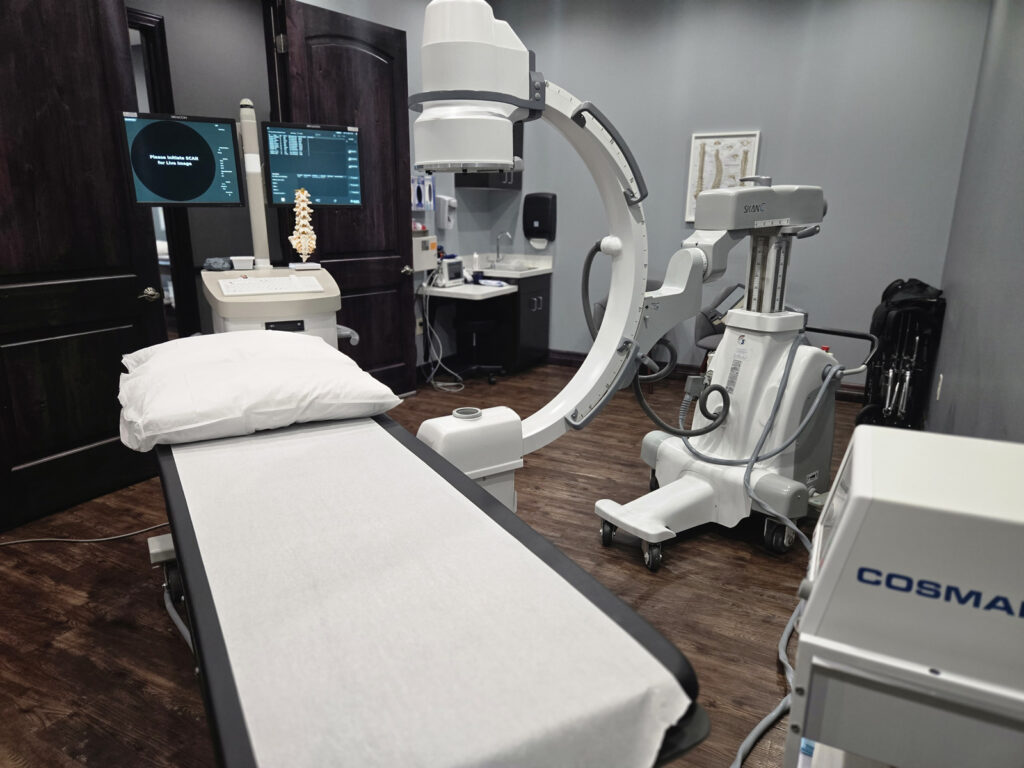Epidural Steroid Injections
Understanding Epidural Steroid Injections
Relief for Radiating Back and Leg Pain
Epidural steroid injections (ESIs) are one of the most effective non-surgical treatments for radiating back and leg pain. By delivering powerful anti-inflammatory medication directly into the epidural space around the spinal nerves, this procedure can calm irritation, reduce swelling, and provide lasting relief. At Williamson Pain Institute, we use precise image guidance to ensure accuracy and patient comfort.
What Are Epidural Steroid Injections?
An epidural steroid injection places a corticosteroid (anti-inflammatory medicine) and sometimes a local anesthetic into the epidural space — the area around the spinal cord and nerve roots. The goal is to decrease inflammation and reduce the pain signals traveling from the irritated nerves.
ESIs are commonly used to treat:
- Herniated or bulging discs
- Spinal stenosis (narrowing of the spinal canal)
- Sciatica or nerve root irritation
- Degenerative disc disease
- Persistent lower back or neck pain that radiates into the arms or legs

How Nerve Pain Develops
Good To Know
- Not just for surgery patients – ESIs are often used early to manage pain and may help you avoid or delay surgery.
- Relief timeline – You might feel immediate improvement from the numbing medicine, but the steroid effect usually builds over 2–5 days.
- Short, outpatient procedure – The injection takes less than 30 minutes, and most patients return home the same day.
- Works best with other care – Combining injections with physical therapy or activity modification often produces the best long-term results.
How The Procedure Works
Epidural steroid injections are done in our office or outpatient setting under X-ray (fluoroscopy) guidance:
1) Preparation
You will lie comfortably while the skin is cleaned and numbed.
2) Guided Injection
Using X-ray imaging, a thin needle is guided into the epidural space. A mixture of steroid and anesthetic is injected.
3) Recovery
You can usually return home the same day. Some patients notice immediate relief from the anesthetic, while steroid benefits build over several days.
Benefits of Epidural Steroid Injections
- Provides targeted relief at the source of nerve pain
- Reduces inflammation and swelling around irritated nerves
- Can improve mobility and allow participation in physical therapy
- Minimally invasive, outpatient procedure
- May delay or prevent the need for surgery
Risks & Safety
Next Steps
If you have persistent back, neck, or nerve pain that radiates into your arms or legs, an epidural steroid injection may be an effective next step. At Williamson Pain Institute, our physicians will carefully evaluate your condition and recommend a personalized treatment plan.
Call Williamson Pain Institute today to schedule a consultation and learn if epidural steroid injections are right for you.
Insurance accepted. Most plans, including Medicare, cover hip injections when medically necessary. We’ll verify your benefits and guide next steps.

Your Questions Answered
It’s a procedure where a steroid (anti-inflammatory medicine) and sometimes a numbing agent are placed into the epidural space around the spinal nerves to reduce swelling and pain.
They are most commonly used for herniated discs, spinal stenosis, sciatica, degenerative disc disease, and nerve root irritation causing pain that radiates into the arms or legs.
Most patients feel only mild pressure or a quick pinch. The skin is numbed beforehand, and X-ray guidance ensures accuracy and comfort.
Some patients notice immediate relief from the anesthetic, but the steroid medication may take 2–5 days to reach full effect.
Relief can last from several weeks to several months. Some patients may require a series of injections for longer-term management.
Yes. When performed by an experienced physician under image guidance, risks are low. Temporary soreness, headache, or facial flushing may occur. Serious complications are very rare.
Sometimes a series of injections is recommended for maximum benefit, especially if pain relief is partial or temporary after the first injection.
